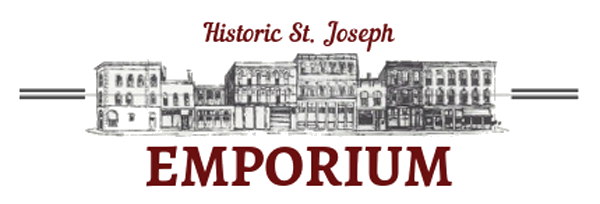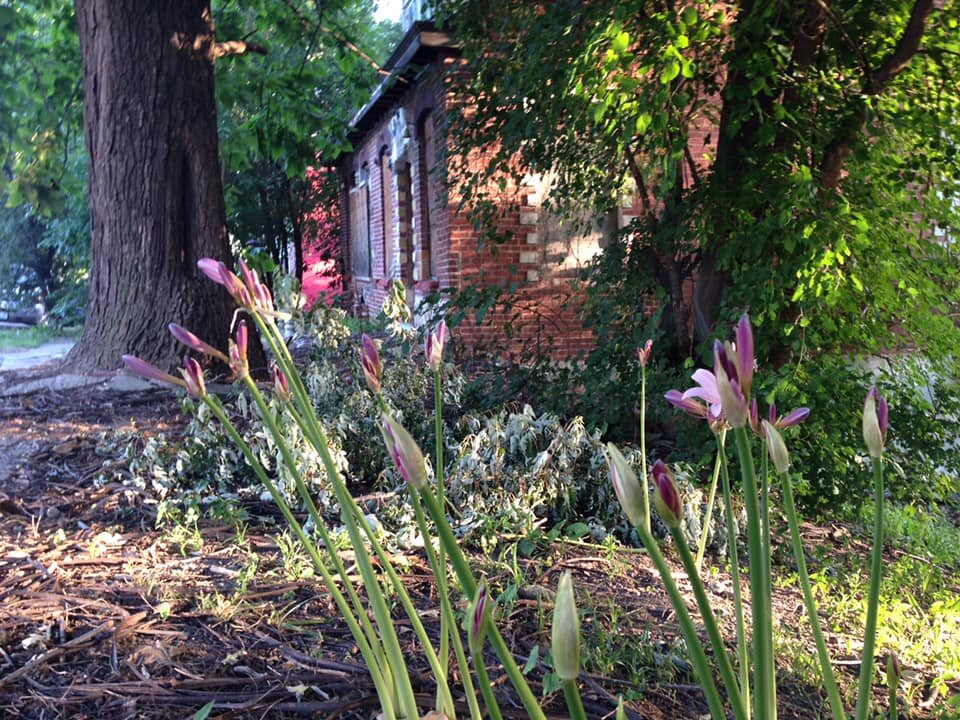Purchase Price $22,000 (each)
These unique properties have been stabilized and secured, but are in need of someone to put in the hard work to make them livable.
For Sale by Owner
House Histories & Gallery
The Lollie Siegel Home, 610 S. 10th
Joseph Hopkins built this elegant early Italianate home around 1853, making it one of the few antebellum structures still standing in St. Joseph. The property changed hands a number of times until it was purchased by the clothing merchant David Siegel in 1869. Buying 610 must have felt like coming home to the family as they had lived in the house just next door to the south (demolished in about 1900) for several years before they attempted to find a better life in Nebraska between 1866 and 1869. It was the Siegels who put on the rear addition in 1870. David was married to Henrietta Hamburger Siegel and they had three children: Eleanor (Lollie), Louis, and Laura. That year the family’s personal estate was worth $1,600 and his real estate was valued at $10,000 (roughly $200,000 in today’s money). The Siegels were quite well-to-do and generally had live-in servants at the home, several of which were Eastern European immigrants and they had an African-American chauffeur, Harry Williams, in 1910.
Following David’s death from heart disease in April 1892, the family continued to live in the home and it functioned as the center of family life and an important gathering space for the expanding Jewish community in the area. When Henrietta’s mother, Dina Hamburger, died her funeral was held at the house. A happier event that same year was the marriage of their daughter Eleanor (Lollie) to the clothing retailer Nathan Block on July 3. David and Henrietta’s son Lewis never married and he continued to live with his mother until her death in 1929.
In 1916 tragedy struck, Lollie Siegel Block died unexpectedly in Omaha on June 18. Her body was returned to St. Joseph and she was buried at Adath Joseph Cemetery. As a memorial to a beloved family member Nathan Block, Henrietta, and Lewis gifted 610 S. 10th Street (then said to be worth $10,000 – roughly $225,000 in today’s dollars) to the Federated Jewish Charities of St. Joseph, MO on June 23, 1916. The terms of the gift required that the property be used for educational and charitable purposes and that it be known as the Lollie Siegel Block Memorial House.
This generous gift provided a needed resource for the Jewish community in that area. Temple B/nail Sholem was right across the street and soon the Settlement House was being used to teach new Jewish immigrants the skills they needed to make a success of themselves in St. Joseph. In 1923 there was an enrollment of 24 students aged 16 to 40 who were able to take advantage the education on offer. The Lollie Siegel House remained an important asset as the community around it began to change. Most of the Jewish community in St. Joseph had left the city by the mid-20th century and the expense of maintaining the property was more than the Federated Jewish Charities felt that they could bear.
The Bohot, 620 S. 10th St.
The Bohot house at 620 S. 10th has always been a hard-working building. It was built as a double house to serve as an income-producing property. Over the decades it has been home to hard working families, many of which were members of St. Joseph’s thriving Jewish community.
One of the most colorful figures associated with this house was Harry Fox, who called 620 S. 10th St. home in the early 1920s. By that time he must have been well-known in the community and no doubt tongues were wagging when he moved in to the neighborhood. Harry was a businessman who often seemed to skate just on the edge of what was legal, and at times put his foot wrong. More than once he was arrested on charges of doing business on Sunday. In 1911, Harry was in the men’s furnishings (men’s clothing and accessories) business. He declared bankruptcy that year and apparently entered in to a scheme with his brother-in-law Hyman Lipschitz to drfraud the system. They purchased Harry’s stock at a discount price and then made a huge profit. The county trustee who was in charge of making sure the bankruptcy proceeded without incident caught wind of it and sued Hyman and others associated with the plan. In the early 1920s, when he was living in the Bohot he was back in business with a shop at 610 S. 6th Street.
The neighbors likely breathed a sigh of relief when Harry moved out and the Simstein family moved in. By 1923, the Simsteins were operating a grocery store out of one side of the house and living in the other. This was the beginning of nearly 50 years of 620 being a neighborhood grocery store under a variety of owners. It was likely during this period that the house’s floorplan was altered away from its original double house structure to better accommodate the grocery business.
The Folk Art Houses
In 1965 prominent St. Joseph mason Bobby G. Bohot purchased 610 and later in 1969, he acquired 620 S. 10th St. He set about decorating their facades with masonry objects he cast himself as well as other found items. He utilized 620 as a junk shop and art studio, even going so far as to inscribe his name “BOHOT” on a masonry block and install it on the front of the building. He left several examples of his masonry work on the building, including different tooling joints. He taught both of his sons the masonry trade and they practiced on these houses. Most of his appliqués were made by melting down lead weights from car tires and then creating molds from which he would do plaster castings. Bohot had said that his designs told a story and every element played a role. Unfortunately, he died before revealing the stories.
Because of Bohot’s obsessiveness with the décor and storytelling of his embellishments, he should be considered an “outsider artist” – one who created art in its most raw and uninhibited form and was seen to exist outside the established culture and society. It is unclear if Bobby G. Bohot considered himself an artist; however, his works are not only well-known locally, but caught national attention as well. Bohot and his family lived in the neighboring house at 610 South 10th, which was documented by Historic American Buildings Survey in 1986 and called “Architect’s Folly.” Bohot owned both properties until his death in 2003, whereupon they fell into disrepair.
The current owners of the Bohot literally saved it from the wrecking ball. The city had ordered it demolished and the demolition crew had the wrecker parked in the backyard. An immediate change of ownership was the only way to stop the demolition, which had been halted to allow the removal of exterior asbestos tiles. Within weeks of purchase, the back wall of the addition fell after a torrential rainstorm. As the addition was neatly removed, the owners decided to return the house back to its original footprint.
Both 610 and 620 are eligible for national, regional, and local grants including the Save Our Heritage grants from the City of St. Joseph.











